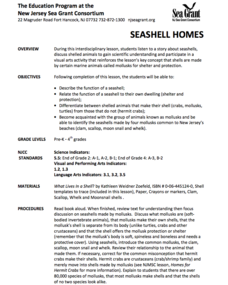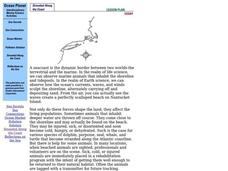American Museum of Natural History
What's This? Sensing
There is a scallop that relies on sight so much that it actually has more than 100 eyes! There are many species that rely heavily on one sense or another. An online interactive resource has youth read about several of these animals. The...
Curated OER
Picture Scramble: Giant Pacific Scallop, Blue Crab, Sea Sack
In this science and visual discrimination worksheet, students examine images of a giant pacific scallop, blue crab and sea sack. Next to each picture is the same image which has been divided into 9 pieces and scrambled. Students place...
Curated OER
Mouthwatering Mollusks
Students investigate various forms of aquatic life. They use four senses, touch, taste, smell, and observation to explore mollusks. Students cook and taste various types mollusks, such as mussels, scallops, and squid.
Curated OER
Color Me- Common Seashore Creatures
For this science animal coloring worksheet, students color black-line pictures of 4 common seashore creatures. They color a Calico Scallop, a Blue Crab, a Hermit Crab, and a Sea Grape.
Curated OER
Marine Science
In this biology worksheet, students identify and locate various vocabulary terms relating to species found in the ocean. There are 21 marine terms located in the word search.
Curated OER
Word Search: Common Seashells
Here is a wordsearch on common seashells. There are 25 shell words that have to be found in the search. Each one has a colorful and accurate picture on the worksheet. An answer key is included.
Curated OER
Sarah, Plain and Tall Study Guide
Patricia MacLachlan’s award-winning novel, Sarah, Plain and Tall, is the focus of a comprehensive study guide. For each chapter, readers answer fact-based and interpretative questions, define and use vocabulary words in a sentence, and...
New South Wales Department of Education
Invertebrates
Of all invertebrates, insects by far are the most numerous. Scholars discuss invertebrates and then use a key to classify them. They see different examples and must describe features of each organism based upon the key.
Biology Junction
Dissection of the Clam
Is the structure of a clam really as simple as it seems? Young scholars explore the anatomy of the clam in an engaging lesson presentation. The lesson highlights the digestive process of the clam as well as how it moves and what it does...
Biology Junction
Introduction to Animals
Out of all animals, elephants alone lack the ability to jump. Scholars learn all about animals using a presentation full of fun examples. It describes different types of animals, the biological similarities and differences between...
Curated OER
Seashell Homes
Pupils listen to a story about seashells. They discuss shelled animals. Learners describe the function of seashell. Pupils relate the function of a seashell to their own dwelling. They differentiate between shelled animals that make...
Curated OER
Classifying Commercial Marine Species
Students investigate taxonomy. They explore some of the commercial marine species caught in Magdalena Bay and develop a classification system for presented animals.
Curated OER
Introduction to Wetlands
Young scholars describe the characteristics of a wetland, identify plants and animals found there, and how those plants and animals have adapted to their environment. They visit stations, view a video, and complete a KWL about the wetlands.
Curated OER
Classification and Identification
Students, after exploring and analyzing diagrammatic and taxonomic keys and their association to marine sciences, identify and classify objects and organisms based on visual attributes/characteristics. They research and create their own...
Curated OER
Shapes (Geometric)
Second graders explore geometric shapes. In this lesson about geometry, 2nd graders create their own vest using geometric shapes. Students work with a partner and fit their partner for the vest they design. Students understand geometric...
Curated OER
Symbols of North Carolina
In this interactive North Carolina worksheet, 4th graders explore symbols of North Carolina. Students complete sixteen multiple choice questions about North Carolina.
Curated OER
Fossil History
Students examine the similarities and differences between living organisms and fossils. In this fossil lesson students reenact the process of creating a fossil.
Curated OER
What Lives In A Shell?
Younger students focus on animals and animal habitats in the lower grades. This resource defining habitats focuses on sea animals with shells, but could be augmented to be a richer experience.
Curated OER
Abstract Flowers Inspired By Georgia O'Keeffe
Students create a drawing of a flower using Georgia O'Keeffe as their inspiration, then develop skills in drawing and composition. They explain the difference between realistic and abstract.
Curated OER
Abstract Flowers Inspired By Georgia O'keeffe
Young scholars create "abstract flowers" using the artwork of Georgia O'Keefe and knowledge of warm and cool colors in this Art lesson for grades K-12. The lesson includes a short recommended book list and a biography of Georgia O'Keefe.
Curated OER
Maggie's Journal Brainteasers
In this Maggie's Journal brainteasers worksheet, students solve two word problems with logic and basic arithmetic skills.
Curated OER
High School Marine Science at its Best: Research Collaboration
Young scholars formulate a more accurate understanding of the true nature of scientific research and the challenges and rewards of field investigations.
Curated OER
What Bees Eat
Students consider the concept that plants and animals are dependent on one another and role-play the interaction between bees and flowers. They identify crops that are dependent on pollination by bees.
Curated OER
Stranded Along The Coast
Students reflect and investigate how a seacoast is the dynamic border between two worlds-the terrestrial and the marine. In the realm of life science, we can observe marine animals that inhabit the shoreline and tidepools. In the realm...

























